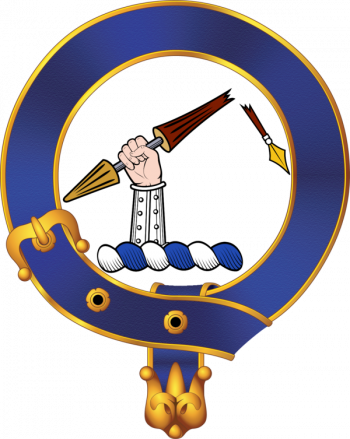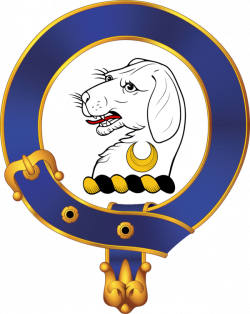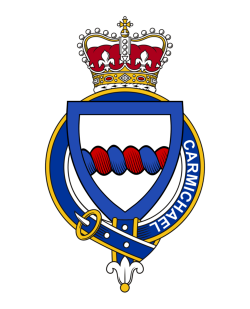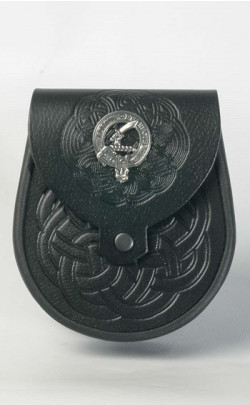
Clan Carmichael
ALWAYS READY
Clan Carmichael take their name from the lands in upper Lanarkshire where they settled. Carmichael translates as "Michael's fort". The barony of Carmichael was confirmed in 1414.
An early Carmichael hero was Sir John de Carmichael of Meadowflat. While fighting with the French army against an English invation, he unhorsed the English commander, breaking his spear in the process. Sir John rode in combat against the English commander and unhorsed him, breaking his own spear in the action. The English subsequently fled from the field. The broken spear in the Carmichael clan crest commemorates this victory.
His grandaughter Catherine was a mistress of King James V, and she had a son by him who was half brother to Mary Queen of Scots.
The Carmichael clan motto is "Tout Jour Prest" (Always Ready) and the clan crest is an armoured hand holding a broken spear.
Scottish History
of Clan Carmichael
On the field of battle
Found in a number of rather bewildering spelling variations that include Carmichail and Carmichale, Carmichael is a surname that has resonated throughout the pages of Scottish history from earliest times.
A name meaning ‘son of Michael’ or ‘servant of Michael’ it also has a separate derivation from the village of Carmichael, between Biggar and Lanark, in present day South Lanarkshire, in the Scottish Lowlands.
A clan quite distinct from Clan Carmichael of Lanarkshire was also present from earliest times in Galloway, in the southwest of Scotland, and further northwest in the Highlands of Argyll.
The Gaelic form of the name for this family was Mac Gillemichael, or Mac Michael, and it was the Mac Michaels of Argyll who are recognised as a sept, or sub-branch, of the proud West Highland clan the Stewarts of Appin.
It is through these separate identifications with Clan Carmichael of Lanarkshire and the Stewarts of Appin that bearers of the name today can lay claim to a proud heritage rooted deep in the ancient soil of Scotland.
In Lanarkshire, the Carmichaels were closely allied with Clan Douglas, and it was this powerful clan that in the late fourteenth century granted the lands of Carmichael to Sir John Carmichael.
Also known as the barony of Carmichael, these lands were in turn originally granted to Clan Douglas by the great warrior king Robert the Bruce in 1321.
Recognised as 30th Chief of the Name and Arms of Carmichael and 26th Baron of the lands of Carmichael, Richard Carmichael and his family, as proud custodians of the family heritage, today operate a working farm and the Discover Carmichael Centre on the ancient baronial lands.
It was as a close ally of Clan Douglas, whose motto is Never Behind and crest a green salamander, that the Carmichaels fought at the battle of Otterburn in August of 1388.
James Douglas, 2nd Earl of Douglas, had led a Scottish force over the border into Northumberland and ravaged the countryside around Newcastle and Durham.
Henry Percy, 1st Earl of Northumberland, had despatched his two sons, Ralph Percy and Henry “Hotspur” Percy to engage with the Scots near Otterburn – while he lay in wait at Alnwick to cut off what he confidently and mistakenly thought would later be the Scots’ disorganised retreat back over the border.
But the battle resulted in a resounding defeat for the English – although Douglas himself was killed.
So significant was the Scottish victory, one in which the Carmichaels had participated, that it later became the subject of two popular ballads – including The Ballad of Chevy Chase and The Battle of Otterburn.
An odd footnote to the battle comes from nearly 600 years later, in 1960, when a number of witnesses claimed they had seen a ‘phantom army’ near the site of the battle.
One of the witnesses, who had been travelling in a taxi on the road running past the battlefield, said: “Suddenly the engine died, the fare-meter went haywire and the taxi felt as if it was being forced against an invisible wall.
“The soldiers seemed to close in on us and then fade into thin air.”
There were also reports that the ‘phantom army’ had been witnessed at other times in the past.
On decidedly more solid ground than ‘phantom’ armies, Sir John Carmichael of Douglasdale gained fame as a member of the Franco-Scots army at the battle of Baugé.
Fought in March of 1421 at Baugé, east of the French town of Angers during the Hundred Years War, the battle resulted in a major victory for the Franco-Scots over an English army led by Thomas of Lancaster, 1st Duke of Clarence, brother of England’s Henry IV.
The Franco-Scots, who fought under the terms of the famed ‘Auld Alliance’ between the two nations, were commanded by Gilbert de Lafayette, the Constable of France, and John Stewart, 2nd Earl of Buchan.
Among the 6,000 Scots on the battlefield was Sir John Carmichael, who gained glory after charging the Duke of Clarence and unseating him from his horse – breaking his lance in the process – while the Duke was later slain by other Scots as he lay on the ground.
It was in commemoration of his deed that the Carmichaels later proudly adopted the crest on their Coat of Arms of an armoured hand holding aloft a broken lance.
In recognition of his services to the French cause, Carmichael was rewarded with the lucrative Bishopric of Orleans and became known in France as Jean de St Michel.
Hosted by Richard Carmichael, 30th Chief of Carmichael, an International Carmichael Gathering was held on their ancient lands in the summer of 2010 – with one of its themes a celebration of the life and times of one of its famous female forebears.
This was Kathleen Carmichael, a daughter of Sir John Carmichael of the Meadowflats, Lanarkshire, cadet branch of the clan, who was a favoured mistress of James V, who reigned from 1513 to 1542.
The son of their union, James Stewart, whose birth was legitimised by Papal decree, became Prior of Coldingham Abbey.
A half-brother of the ill-starred Mary, Queen of Scots, his son was Francis Stewart, Earl of Bothwell.
In May of 1546, four years after the death of James V and during the troubled minority of his heir Mary, Peter Carmichael of the Balmedie, Fifeshire, branch of the family was one of the murderers of Cardinal Beaton.
Appointed Archbishop of St Andrews in 1539 and made Papal legate to Scotland five years later, the powerful Cardinal incurred the wrath of many when, in March of 1546 he was instrumental in the arrest, trial and subsequent execution by burning of the popular nonconformist preacher George Wishart.
It was in revenge for this that a party of powerful conspirators, who included Carmichael and William Kirkcaldy of Grange, murdered him after gaining entry to his private chambers in the castle of St Andrews.
Not satisfied with merely murdering him, they then mutilated his corpse and hanged it from a castle window for all to see.
As punishment, Carmichael was sentenced to spend time fettered to an oar in the galleys – a fate also shared by the Protestant Reformer John Knox.
In common with Knox, however, the rapidly shifting religious and political allegiances of the times soon found him released from his grim fate.
Rebellion and anarchy
It was in the particularly turbulent sixteenth century that Sir John Carmichael held a powerful position as one of the Wardens of the Borders Marches – with the onerous remit of attempting to control the anarchic activities of the Border Reivers.
These reivers took their name from their lawless custom of reiving, or raiding, not only their neighbours’ livestock, but also that of their neighbours across the border.
The word ‘bereaved’, for example, indicating to have suffered loss, derives from the original ‘reived’, meaning to have suffered loss of property.
A Privy Council report graphically described how the “wild incests, adulteries, convocation of the lieges, shooting and wearing of hackbuts, pistols, lances, daily bloodshed, oppression, and disobedience in civil matters, neither are nor has been punished.”
A constant thorn in the flesh of both the English and Scottish authorities was the cross-border raiding and pillaging carried out by well-mounted and heavily armed men, the contingent from the Scottish side of the border known and feared as ‘moss troopers.’
In an attempt to bring order to what was known as the wild ‘debateable land’ on both sides of the border, Alexander II of Scotland had in 1237 signed the Treaty of York, which for the first time established the Scottish border with England as a line running from the Solway to the Tweed.
On either side of the border there were three ‘marches’ or areas of administration, the West, East and Middle Marches, and a warden governed these.
Sir John Carmichael, known as the Keeper of Liddesdale, was Warden of the West March.
Complaints from either side of the border were dealt with on Truce Days, when the wardens of the different marches would act as arbitrators.
There was also a law known as the Hot Trod, that granted anyone who had their livestock stolen the right to pursue the thieves and recover their property.
In the Scottish borderlands, the Homes and Swintons dominated the East March, while the Armstrongs, Maxwells, Johnstones and Grahams were pre-eminent in Sir John’s territory of the West March.
The Kerrs, along with the Douglases and Elliots, held sway in the Middle March.
What occasionally united the warring factions was opposition to their counterparts across the border, and in July of 1575 Sir John Carmichael led a party of his countrymen in what became celebrated in ballad as the Raid of the Redeswire.
One of the last such Border raids of its kind, it took place at the Cheviot Pass, when the heavily-armed Scots met with an equally heavily-armed body of English – ostensibly to discuss the terms of a truce.
Insults were traded by both sides before this gave way to full-scale battle and the eventual routing of the English and the death of several of their leaders, including Sir George Heron, Keeper of Redesdale.
The Union of the Crowns of Scotland and England did not occur until the accession of James I (James VI of Scotland) to the English throne in 1603 – and the Raid of the Redeswire is recognised as the last major battle between the Kingdom of Scotland and the Kingdom of England.
Five years later, Sir John Carmichael was ambushed and murdered by a party of Armstrongs as he was en route to attend a Warden Court.
Moving from the Clan Carmichael home of Lanarkshire, in the Lowlands, to the West Highlands, bearers of the Carmichael name in its Gaelic versions of Mac Gillemichael and Mac Michael were kinsfolk of the Stewarts of Appin.
It was through this close kinship that they are recognised, along with others who include the Livingstones and Mackinlays, as a sept of the clan.
As such, they shared in both the clan’s glorious fortunes and tragic misfortunes.
Known as the Loyal Clan because of their staunch support of the Royal House of Stewart (or Stuart), the motto of the clan is Wither will ye and crest the head of a unicorn.
With their main seat from earliest times being Castle Stalker, in Appin, in the north of Argyll, they were frequently to be found on the field of battle in the Stuart cause – along with their Carmichael kinsfolk.
A bitter civil war raged in Scotland from 1638 to 1649 between the forces of those Presbyterian Scots who had signed a National Covenant that opposed the divine right of the Stuart monarchy and Royalists such as James Graham, 1st Marquis of Montrose, whose prime allegiance was to Charles I.
Although Montrose had initially supported the Covenant, his conscience later forced him to switch sides, and it was at his side that the Stewarts of Appin and kinsfolk such as the Carmichaels fought.
His great campaigns were fought from 1644 to 1645 – a year that became known as the Year of Miracles because of his brilliant military successes.
These included the battle of Inverlochy, in February of 1645, when the Earl of Argyll was forced to ignominiously flee in his galley after 1,500 of his Covenanters were wiped out in a surprise attack.
What makes Montrose’s victory all the more notable is that his hardy forces had arrived at Inverlochy after an exhausting 36-hour march south through knee-deep snow from the area of the present-day Fort Augustus.
He enjoyed another great victory at Kilsyth in August of the same year, but final defeat came at the battle of Philiphaugh, near Selkirk, less than a month later.
The Stewarts of Appin and their Mac Michael/Carmichael kinsfolk were also prominent in their support of Prince Charles Edward Stuart.
The prince had landed on the small Outer Hebridean island of Eriskay on July 22, 1745, arriving on the mainland at Loch nan Uamh three days later.
The Stuart Standard was raised a few weeks later, on August 19, at Glenfinnan, on Loch Shiel, and the Stewarts of Appin were among those clans who rallied to what is known as the Jacobite cause.
Victory was achieved at the battle of Prestonpans in September, and in October the confident prince and his army set off on the long march south to London to claim what was believed to be the rightful Stuart inheritance of the throne.
The army reached only as far as Derby, however, before the controversial decision was taken in early December to withdraw back over the border.
Jacobite hopes were finally dashed forever at the battle of Culloden, fought on Drummossie Moor, near Inverness, on April 16, 1746.
Hundreds of clansmen died on the battlefield while hundreds of others, including Carmichaels, died later from their wounds and the brutal treatment of their Government captors.
From the bloody battlefield of Culloden and back to the Carmichaels of Lanarkshire, Sir James Carmichael had been raised to the peerage in 1647 as 1st Lord Carmichael, while his son married a Douglas heir.
Their son, in turn, was created Earl of Hyndford as reward for his support of the Royalist cause of Charles I.
The 2nd Earl of Hyndford, however, supported the Parliamentary cause and helped to defeat Montrose’s forces at the battle of Philiphaugh.
In keeping with what is frequently the complex genealogy of noble Scottish families and clans such as the Carmichaels, it was through marriage, in this case the marriage of Lady Margaret Carmichael, a daughter of the 2nd Earl of Hyndford, to Sir John Anstruther, that the family eventually became, in 1817, known as Carmichael-Anstruther.
Nearly 165 years later, in 1981, following the death a year earlier of Sir Windham Carmichael-Anstruther, 25th Baron of Carmichael, Richard Carmichael – then a young accountant living and working in New Zealand – was officially recognised as 26th Baron of Carmichael and 30th Chief of the Name.
The family name then reverted back from Carmichael-Anstruther to Carmichael – returning to its roots in more ways than one as the 30th Chief and his family settled on the ancient Carmichael lands.
Family History Mini Book
We hope you enjoyed reading this excerpt from this mini book on the Scottish history of the Carmichael family.
You can buy the full book for only108 Clan Carmichael
Tartan Products
The Crests
of Clan Carmichael

































































